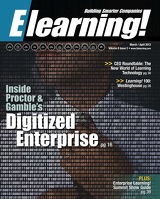Elearning! Magazine: Building Smarter Companies via Learning & Workplace Technologies.
Page 14 of 52
Businessof Learning Although this is a greatly simplified example, if you understand this methodology, you can easily
apply it to the list of several hundred features and functions needed in your new LMS. You might even have features grouped into categories, like product features, vendor performance, client satisfaction, technical considerations, system architecture, pricing, content availability and so on. Each of these cat- egories may in turn have an overall weight, thereby changing the importance of various elements —
like pricing, which may carry a 50 percent weight even though you have five categories. However, in both the personal example and for your new LMS, there may be "gating criteria," such
as salary or e-commerce considerations. Simply use these criteria as the minimum entry point for fur- ther consideration.
'BAKE-OFFS'
In very large, multi-million dollar purchases, bake-offs are sometimes added as a final vendor test cri- teria. At the outset, know that getting the criteria right, as well as measuring actual performance is a complex undertaking. To do it right, here are the high-level steps leading up to, and including, a
proof-of-concept: >>Information Gathering – The goal of this step is to find enough compelling information to give >>you a reason to progress on to the next step.
Product Installation – This is the "test drive" of the product, once you determine you want to move forward. Make sure you have the latest version and that it operates in your technical envi- ronment if you're installing it locally. With the advent of cloud computing and SaaS, this part is >>becoming easier.
Product Testing/Technical Evaluation – This is a wide ranging topic, but the usual goals are to see first-hand: ease-of-installation, how easy it is to find and access the LMS, the ease of getting started and using the system, proof that tools exist as promised, technical diffi-
culties experienced, and product stability. >> Technical Proof of Concept/Technical Bake-Off – Making it to this step means that you have seen very compelling reasons to take a serious look as to whether this is a viable product for your company. It's at this stage that you are either doing a head-to- head competition against an incumbent product, or you are attempting to use the product in a way that mimics your everyday intended use of the product. In summary, a technical proof of concept/
bake-off is a final-stage event that involves a large investment of time from yourself and other stakeholders. The goal is to see how the learning system operates in situations that represent your typical use of the prod- uct, whether or not it performs as expected, or whether it surpasses what your current LMS offers. A final word of caution: remember to
predefine the "success criteria" for the bake- off. Otherwise, this is a process that can go on well beyond its intended conclusion.
14 March / April 2012 Elearning!
